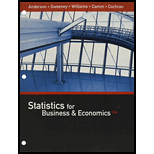
Concept explainers
To assess consumer acceptance of a new series of ads for Miller Lite Beer. Louis Harris conducted a nationwide poll of 363 adults who had seen the Miller Lite ads. The following responses are based on that survey. (Note: Because the survey sampled only a small fraction of all adults, assume (N − n)/N = 1 in any formulas involving the standard error.)
- a. Nineteen percent of all respondents indicated they liked the ads a lot. Develop a 95% confidence interval for the population proportion.
- b. Thirty-one percent of the respondents disliked the new ads. Develop a 95% confidence interval for the population proportion.
- c. Seventeen percent of the respondents felt the ads are very effective. Develop a 95% confidence interval for the proportion of adults who think the ads are very effective.
- d. Louis Harris reported that the “margin of error is five percentage points.” What does this statement mean and how do you think they arrived at this number?
- e. How might nonsampling error bias the results of such a survey?
a.
Obtain a 95% confidence interval for the population proportion.
Answer to Problem 18SE
The 95% confidence interval for the population proportion is
Explanation of Solution
Calculation:
In a nationwide poll, 19% out of 363 adults who have seen the Miller Lite ads, liked the ads a lot.
Confidence interval:
The approximate 95% confidence interval estimate of the population proportion is
Where
Substitute
Thus, the standard error of the proportion is 0.0206.
Confidence interval:
Thus, the approximate 95% confidence interval for the population proportion is
b.
Obtain a 95% confidence interval for the population proportion.
Answer to Problem 18SE
The 95% confidence interval for the population proportion is
Explanation of Solution
Calculation:
The respondents who disliked the new ads are 31%.
Substitute
Thus, the standard error of the proportion is 0.0243.
Confidence interval:
Thus, the approximate 95% confidence interval for the population proportion is
c.
Obtain approximate 95% confidence interval for the proportion of adults who think the ads are very effective.
Answer to Problem 18SE
The approximate 95% confidence interval for the proportion of adults who think the ads are very effective is,
Explanation of Solution
Calculation:
The respondents who felt the ads are very effective is 17%.
Substitute
Thus, the standard error of the proportion is 0.0197.
Confidence interval:
Thus, the approximate 95% confidence interval for the proportion of adults who think the ads are very effective is
d.
Explain the statement and find the number they got.
Explanation of Solution
Calculation:
The statement “margin of error is five percentage points” is reported by Louis Harris.
The standard error is largest when
Now,
Here by multiplying the standard error with 2 the bound is,
Hence, for the sample of 363, the bond would be 5% when
e.
Explain whether the non-sampling error biased the results of the survey or not.
Explanation of Solution
When the poll is conducted by calling people at home during day time then the sample results represents for the adults who are not working outside the home. The Louis Harris organization took precautions against this that causes bias.
Want to see more full solutions like this?
Chapter 22 Solutions
Bundle: Statistics for Business & Economics, Loose-Leaf Version, 13th + MindTap Business Statistics with XLSTAT, 1 term (6 months) Printed Access Card
- A well-known company predominantly makes flat pack furniture for students. Variability with the automated machinery means the wood components are cut with a standard deviation in length of 0.45 mm. After they are cut the components are measured. If their length is more than 1.2 mm from the required length, the components are rejected. a) Calculate the percentage of components that get rejected. b) In a manufacturing run of 1000 units, how many are expected to be rejected? c) The company wishes to install more accurate equipment in order to reduce the rejection rate by one-half, using the same ±1.2mm rejection criterion. Calculate the maximum acceptable standard deviation of the new process.arrow_forward5. Let X and Y be independent random variables and let the superscripts denote symmetrization (recall Sect. 3.6). Show that (X + Y) X+ys.arrow_forward8. Suppose that the moments of the random variable X are constant, that is, suppose that EX" =c for all n ≥ 1, for some constant c. Find the distribution of X.arrow_forward
- 9. The concentration function of a random variable X is defined as Qx(h) = sup P(x ≤ X ≤x+h), h>0. Show that, if X and Y are independent random variables, then Qx+y (h) min{Qx(h). Qr (h)).arrow_forward10. Prove that, if (t)=1+0(12) as asf->> O is a characteristic function, then p = 1.arrow_forward9. The concentration function of a random variable X is defined as Qx(h) sup P(x ≤x≤x+h), h>0. (b) Is it true that Qx(ah) =aQx (h)?arrow_forward
- 3. Let X1, X2,..., X, be independent, Exp(1)-distributed random variables, and set V₁₁ = max Xk and W₁ = X₁+x+x+ Isk≤narrow_forward7. Consider the function (t)=(1+|t|)e, ER. (a) Prove that is a characteristic function. (b) Prove that the corresponding distribution is absolutely continuous. (c) Prove, departing from itself, that the distribution has finite mean and variance. (d) Prove, without computation, that the mean equals 0. (e) Compute the density.arrow_forward1. Show, by using characteristic, or moment generating functions, that if fx(x) = ½ex, -∞0 < x < ∞, then XY₁ - Y2, where Y₁ and Y2 are independent, exponentially distributed random variables.arrow_forward
- 1. Show, by using characteristic, or moment generating functions, that if 1 fx(x): x) = ½exarrow_forward1990) 02-02 50% mesob berceus +7 What's the probability of getting more than 1 head on 10 flips of a fair coin?arrow_forward9. The concentration function of a random variable X is defined as Qx(h) sup P(x≤x≤x+h), h>0. = x (a) Show that Qx+b(h) = Qx(h).arrow_forward
 Glencoe Algebra 1, Student Edition, 9780079039897...AlgebraISBN:9780079039897Author:CarterPublisher:McGraw Hill
Glencoe Algebra 1, Student Edition, 9780079039897...AlgebraISBN:9780079039897Author:CarterPublisher:McGraw Hill Holt Mcdougal Larson Pre-algebra: Student Edition...AlgebraISBN:9780547587776Author:HOLT MCDOUGALPublisher:HOLT MCDOUGAL
Holt Mcdougal Larson Pre-algebra: Student Edition...AlgebraISBN:9780547587776Author:HOLT MCDOUGALPublisher:HOLT MCDOUGAL

